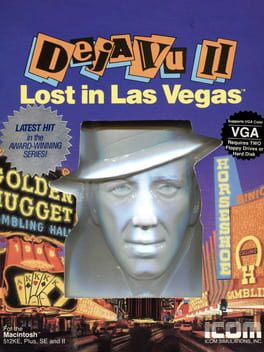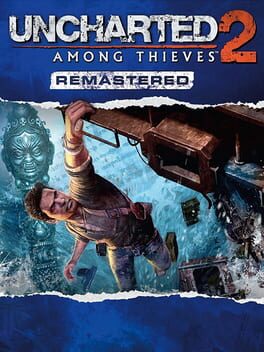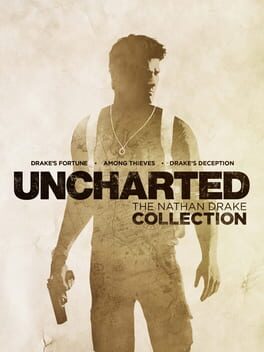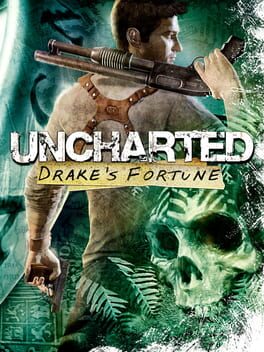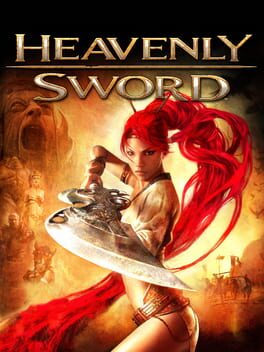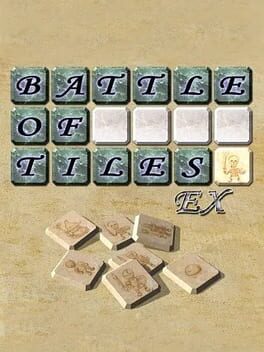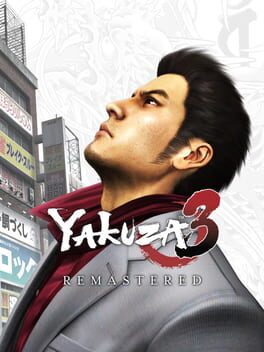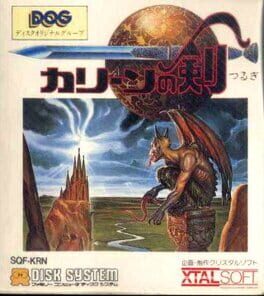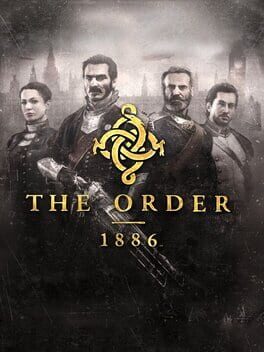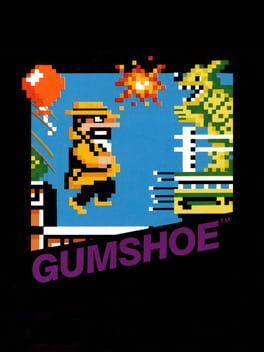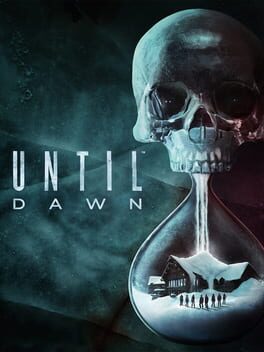WageYoge
An interactive heavy metal album. The hypnotic boom-tch-lak-chock of the super shotgun is forever burned into my brain.
The back half of the game gets really, really difficult at times, but maybe that's just my lack of skill. Conversely, the secrets are generally much easier to find compared to the first game.
Doom II is not my favorite game in the world, but I can't deny how well put-together the whole package is.
The back half of the game gets really, really difficult at times, but maybe that's just my lack of skill. Conversely, the secrets are generally much easier to find compared to the first game.
Doom II is not my favorite game in the world, but I can't deny how well put-together the whole package is.
1993
Debuting just a year and a half after Wolf3D, it's nearly impossible to overstate how far ahead Doom was compared to every other PC action game at the time. There were other, more ambitious first-person games (Ultima Underworld, System Shock, hell even Terminator Rampage), but nothing came close to Doom in its fluid and relentlessly visceral action.
An undeniable classic, and the gameplay still holds up really well as long as you use strafe controls (or just use GZDoom).
The sound design impressed me the most this time, from the bestial grunts and cries of the undead marines and demons, to the unsettling screeeeeee of the powered doors.
The level design is also quite good, although it gets pretty abstract and doesn't really feel like a real space (whether that be a moon base or the depths of hell). The levels are clearly designed for gameplay first, immersion/realism second, but that decision was the right one to make.
And if you really want to get your ass kicked, you must play the 4th episode Thy Flesh Consumed included in Ultimate Doom. The first two maps are just brutal.
An undeniable classic, and the gameplay still holds up really well as long as you use strafe controls (or just use GZDoom).
The sound design impressed me the most this time, from the bestial grunts and cries of the undead marines and demons, to the unsettling screeeeeee of the powered doors.
The level design is also quite good, although it gets pretty abstract and doesn't really feel like a real space (whether that be a moon base or the depths of hell). The levels are clearly designed for gameplay first, immersion/realism second, but that decision was the right one to make.
And if you really want to get your ass kicked, you must play the 4th episode Thy Flesh Consumed included in Ultimate Doom. The first two maps are just brutal.
Significantly harder than the first game, requiring some obtuse commands (like having to use the flashlight on yourself to turn it on). Whereas the first game gradually and effectively reveals the central mystery to you as you uncover clues, I spent the majority of the second game not understanding wtf I was supposed to do.
The game's final puzzle involves planting evidence in a sneaky double-double-cross of a pair of mobsters, but good luck ever figuring out exactly how to do that without a walkthrough.
The game's final puzzle involves planting evidence in a sneaky double-double-cross of a pair of mobsters, but good luck ever figuring out exactly how to do that without a walkthrough.
Originally a 1985 monochrome adventure game for the Apple Mac, Deja Vu received an attractive NES port by Japanese company Kemco.
It's still quite playable today thanks to how grounded and plausible everything is—there aren't any "cat hair moustache puzzles".
There are a few (more than a few) cheap deaths, but thankfully there's a continue option so you don't lose any progress. There are also a few logical inconsistencies, like how some doors can only be opened with the right key, while other doors have no key and can be opened simply by shooting out the lock.
But overall, it's a solid, classic adventure game delivering a tidy hardboiled mystery that wraps up nicely in the end. The final puzzle is particularly challenging, but also very cool: you realize that you're being framed for murder, so you have to permanently dispose of any evidence that could incriminate you, while also obtaining the three key pieces of evidence that will incriminate your enemies when shown to the police.
It's still quite playable today thanks to how grounded and plausible everything is—there aren't any "cat hair moustache puzzles".
There are a few (more than a few) cheap deaths, but thankfully there's a continue option so you don't lose any progress. There are also a few logical inconsistencies, like how some doors can only be opened with the right key, while other doors have no key and can be opened simply by shooting out the lock.
But overall, it's a solid, classic adventure game delivering a tidy hardboiled mystery that wraps up nicely in the end. The final puzzle is particularly challenging, but also very cool: you realize that you're being framed for murder, so you have to permanently dispose of any evidence that could incriminate you, while also obtaining the three key pieces of evidence that will incriminate your enemies when shown to the police.
Is Uncharted 1 a great game? Ehhh….
I mean, it’s fun. It’s really fun, and that counts for a lot. The problems I have with it are mainly that there are too many tedious gunfights, and the environment traversal, although gorgeously cinematic, is shallow.
The sequels are a massive improvement. The fundamentals are all exactly the same, but the subtle refinements make things so much more fun.
They mix up the combat by adding more opportunities for stealth and melee. Now there are chances to use stealth and melee even after a big gunfight has broken out.
The gunfights are also much more varied and interesting. First of all, they’re much more dynamic. Whereas the first game mainly consisted of these large shooting arenas, where you’re mainly pinned down in a fixed location as multiple waves of enemies come to get you, in Uncharted 2 & 3, there are many gunfights that play out on the move, where you’re making your way through a complex environment, taking out enemies along the way.
They also constantly throw something new into the mix to keep things interesting. Whether it’s a shootout on a runaway train, an attack helicopter, a tank, or jacked-up yeti things, no two gunfights are exactly alike.
I mean, it’s fun. It’s really fun, and that counts for a lot. The problems I have with it are mainly that there are too many tedious gunfights, and the environment traversal, although gorgeously cinematic, is shallow.
The sequels are a massive improvement. The fundamentals are all exactly the same, but the subtle refinements make things so much more fun.
They mix up the combat by adding more opportunities for stealth and melee. Now there are chances to use stealth and melee even after a big gunfight has broken out.
The gunfights are also much more varied and interesting. First of all, they’re much more dynamic. Whereas the first game mainly consisted of these large shooting arenas, where you’re mainly pinned down in a fixed location as multiple waves of enemies come to get you, in Uncharted 2 & 3, there are many gunfights that play out on the move, where you’re making your way through a complex environment, taking out enemies along the way.
They also constantly throw something new into the mix to keep things interesting. Whether it’s a shootout on a runaway train, an attack helicopter, a tank, or jacked-up yeti things, no two gunfights are exactly alike.
Sic Parvis Magna. Greatness from small beginnings.
Indeed.
Uncharted is a riproaring popcorn flick in video game form, but there's too much shooting. The enemies are bullet sponges who turn into freaking Neo from the Matrix when you miss the headshot. Aiming is agonizingly slow. You spend an unnecessary amount of time scavenging for ammo off dead bodies.
They should have mixed up the action some more by having more hand-to-hand (gunless) combat and stealth sections (which is precisely what they did in the sequel). As it is, the constant gun battles get tiresome even as the rest of the game shines.
It affects the plot, too. When you finally get to the library and unlock the secret underground vault that hasn't been opened in 400 years, what do you find? More bad guys of course, who have already set up Klieg lights and are patrolling the place. The demands of the shooter gameplay mean that you just can't escape the bad guys. So Drake's little diary and everything are all kind of pointless; the bad guys are one step ahead of you the whole way (kind of like Raiders of the Lost Ark, which is a major inspiration).
Indeed.
Uncharted is a riproaring popcorn flick in video game form, but there's too much shooting. The enemies are bullet sponges who turn into freaking Neo from the Matrix when you miss the headshot. Aiming is agonizingly slow. You spend an unnecessary amount of time scavenging for ammo off dead bodies.
They should have mixed up the action some more by having more hand-to-hand (gunless) combat and stealth sections (which is precisely what they did in the sequel). As it is, the constant gun battles get tiresome even as the rest of the game shines.
It affects the plot, too. When you finally get to the library and unlock the secret underground vault that hasn't been opened in 400 years, what do you find? More bad guys of course, who have already set up Klieg lights and are patrolling the place. The demands of the shooter gameplay mean that you just can't escape the bad guys. So Drake's little diary and everything are all kind of pointless; the bad guys are one step ahead of you the whole way (kind of like Raiders of the Lost Ark, which is a major inspiration).
2007
This is tough to rate. I am enamored with the wuxia-inspired, non-specific Asian fantasy setting, with its striking landscapes and architecture. It's evocative without being a caricature or cliche. On the other hand, the game doesn't have much time for expansive worldbuilding and lore.
The graphics are great showcase for the PS3, but there are some baaad slowdowns and screen tearing occasionally. The mo-capped facial animations were truly next-gen at the time, though.
The writing is pretty good, but the superb voice acting takes it to a whole other level. The heroines Nariko and Kai, as well as the main villain Bohan (played by Andy Serkis), all have fantastic performances.
On the other hand, everybody is just a little bit nuts.
The villains come off as grotesquely buffoonish. Serkis’s Bohan walks the fine line between menacing villain and pathetic narcissist, a Trump-like figure, but the sub-bosses (Flying Fox, Whiptail, and Roach) are just cartoons that feel out of place against the seriousness of the rest of the story.
Nariko herself is a wonderful lead, a powerful, magnetic presence in the game, but the splash art on the title and loading screens make her look like a pornstar. Surprisingly, the sweet, crazy little Kai is not annoying at all thanks to good character design and outstanding voice acting (TWING TWANG).
The QTEs suck. They come up quite suddenly, can be hard to spot in the moment, distract from the cinematic action, and are quite strict. The ones that require directional input are the worst, because half the time you'll be a little too diagonal on the analog stick (down-left instead of pure left, for example) and the input will fail.
The battle system, focusing on predefined combos and a color-coded counter system, is enjoyable. In this game, you block automatically by waiting in the correct stance and not attacking, and then hitting the counterattack button at the right time. This is clever because it discourages button mashing. Either way, I suck at this type of game generally and there is no easy difficulty option, only a “Hell Mode” that unlocks after you complete the game once. That said, I only died during the boss fights, so the game isn’t too hard overall.
The main points of frustration are the QTEs and the energy beams you have to counter from the last boss, which are really strict timing-wise.
The sixaxis motion controls are terrible and make the game so much harder, but thankfully you can turn them all off. Once I turned off the gyro controls, I really started to enjoy the archery and artillery sections of the game. The game peaks in the 3rd chapter, when you have quick alternating scenes between Nariko and Kai.
I liked the game at first, then I started to hate it, but then I started to like it again towards the end... except for the frustrating final boss fight.
Incidentally, this game also spawned an animated feature film, but it was terrible. The main characters were fairly detailed, but the animations were stiff and lifeless, the non-main characters looked like NPCs from a PS2 game, and the backgrounds were just low-poly mounds with a simple texture applied. It looked more like machinima than theatrical-level animation.
The writing also took a huge nosedive. Boring, wooden dialogue. All the subtle characterizations from the game are gone, whether it’s Kai’s nuttiness, Bohan’s manic narcissim, the sad and tortured relationship between Bohan and his son Roach, or even the little rivalry between Flying Fox and Whiptail. Nariko’s voice actor reprises the role, but her fiercely impassioned delivery from the game is gone, and now she spends the entire movie sounding only lightly chuffed. Kai goes from twing twang in the game to I like blood in the movie. Just garbage screenwriting.
We do get a little extra backstory. Bohan was always a backstabbing jerk who never can get the respect he thinks he deserves. Nariko and Kai are actually biological sisters, because apparently their father Shen went on a big raping spree after Nariko was born, desperately trying to sire a son as the Chosen One. And in fact there is a son, named Loki, but he’s just a blacksmith who is literally stabbed in the back after spouting some contradictory dialogue. That's one way to subvert a trope, I guess, but the whole plotline is just a stupid waste of 1/3 of the screen time.
The whole thing (the movie, not the game) is just awful. A simple compilation of the cutscenes from the game would have been better. Apparently Andy Serkis not only voiced game-Bohan, but also helped write the dialogue and direct the cutscenes. His presence is sorely missed from the movie.
The graphics are great showcase for the PS3, but there are some baaad slowdowns and screen tearing occasionally. The mo-capped facial animations were truly next-gen at the time, though.
The writing is pretty good, but the superb voice acting takes it to a whole other level. The heroines Nariko and Kai, as well as the main villain Bohan (played by Andy Serkis), all have fantastic performances.
On the other hand, everybody is just a little bit nuts.
The villains come off as grotesquely buffoonish. Serkis’s Bohan walks the fine line between menacing villain and pathetic narcissist, a Trump-like figure, but the sub-bosses (Flying Fox, Whiptail, and Roach) are just cartoons that feel out of place against the seriousness of the rest of the story.
Nariko herself is a wonderful lead, a powerful, magnetic presence in the game, but the splash art on the title and loading screens make her look like a pornstar. Surprisingly, the sweet, crazy little Kai is not annoying at all thanks to good character design and outstanding voice acting (TWING TWANG).
The QTEs suck. They come up quite suddenly, can be hard to spot in the moment, distract from the cinematic action, and are quite strict. The ones that require directional input are the worst, because half the time you'll be a little too diagonal on the analog stick (down-left instead of pure left, for example) and the input will fail.
The battle system, focusing on predefined combos and a color-coded counter system, is enjoyable. In this game, you block automatically by waiting in the correct stance and not attacking, and then hitting the counterattack button at the right time. This is clever because it discourages button mashing. Either way, I suck at this type of game generally and there is no easy difficulty option, only a “Hell Mode” that unlocks after you complete the game once. That said, I only died during the boss fights, so the game isn’t too hard overall.
The main points of frustration are the QTEs and the energy beams you have to counter from the last boss, which are really strict timing-wise.
The sixaxis motion controls are terrible and make the game so much harder, but thankfully you can turn them all off. Once I turned off the gyro controls, I really started to enjoy the archery and artillery sections of the game. The game peaks in the 3rd chapter, when you have quick alternating scenes between Nariko and Kai.
I liked the game at first, then I started to hate it, but then I started to like it again towards the end... except for the frustrating final boss fight.
Incidentally, this game also spawned an animated feature film, but it was terrible. The main characters were fairly detailed, but the animations were stiff and lifeless, the non-main characters looked like NPCs from a PS2 game, and the backgrounds were just low-poly mounds with a simple texture applied. It looked more like machinima than theatrical-level animation.
The writing also took a huge nosedive. Boring, wooden dialogue. All the subtle characterizations from the game are gone, whether it’s Kai’s nuttiness, Bohan’s manic narcissim, the sad and tortured relationship between Bohan and his son Roach, or even the little rivalry between Flying Fox and Whiptail. Nariko’s voice actor reprises the role, but her fiercely impassioned delivery from the game is gone, and now she spends the entire movie sounding only lightly chuffed. Kai goes from twing twang in the game to I like blood in the movie. Just garbage screenwriting.
We do get a little extra backstory. Bohan was always a backstabbing jerk who never can get the respect he thinks he deserves. Nariko and Kai are actually biological sisters, because apparently their father Shen went on a big raping spree after Nariko was born, desperately trying to sire a son as the Chosen One. And in fact there is a son, named Loki, but he’s just a blacksmith who is literally stabbed in the back after spouting some contradictory dialogue. That's one way to subvert a trope, I guess, but the whole plotline is just a stupid waste of 1/3 of the screen time.
The whole thing (the movie, not the game) is just awful. A simple compilation of the cutscenes from the game would have been better. Apparently Andy Serkis not only voiced game-Bohan, but also helped write the dialogue and direct the cutscenes. His presence is sorely missed from the movie.
2013
This is a fairly obscure strategy game released on PS3 and iPad.
You have an army of tiles that marches in formation across the screen from left to right, smashing into enemies as you go. The game consists of augmenting and rearranging your forces to take out enemies as efficiently as possible.
It's basically a rudimentary tower offense game, but the concept dates back to the ancient Japanese computer game Bokosuka Wars.
The graphics are... not good. It looks more like a playable prototype rather than a retail game. It's also extremely repetitive.
You have an army of tiles that marches in formation across the screen from left to right, smashing into enemies as you go. The game consists of augmenting and rearranging your forces to take out enemies as efficiently as possible.
It's basically a rudimentary tower offense game, but the concept dates back to the ancient Japanese computer game Bokosuka Wars.
The graphics are... not good. It looks more like a playable prototype rather than a retail game. It's also extremely repetitive.
2018
1987
An adequate early RPG by Xtalsoft. It features a big world map, another big underworld map, and visible on-screen enemies rather than sudden random battles. When you touch one of them, the view switches to a real-time battle screen.
The battle system is bump combat with a few different magic spells. The combat is not as tactical as Dragon Quest, but also not as quick and responsive as Ys, so it's kind of meh. When combat starts you could be facing a single enemy or a dozen, and there's not enough time to react before they start ganging up and stunlocking you, leading to many cheap deaths.
There's a good variety of little enemy sprites, but you only face one type of enemy at a time, and combat is exactly the same throughout, the only difference being enemy strength and the occasional projectile-throwing varieties.
The ending is surprisingly great for a Famicom game—there's a slideshow of images recapping your journey and victory over the evil sorcerer Gradliff.
My favorite part is a little sequence in the beginning. In one town you talk to a priest who says he lost his ring of truth in a forest. In another town, a guy says he found some ring in a forest and gave it to the blacksmith's daughter. So you put 2 and 2 together and realize that the blacksmith's daughter has the ring of truth. Then you find out from another dude that she really likes necklaces more than rings, and eventually—much later—you meet a shifty character in yet another town who will sell you a necklace to give to the girl to get the ring.
I love this breadcrumb style of questing in early RPGs, where talking to NPCs reveals important hints in seemingly trivial dialogue, and it's up to you to piece things together.
The battle system is bump combat with a few different magic spells. The combat is not as tactical as Dragon Quest, but also not as quick and responsive as Ys, so it's kind of meh. When combat starts you could be facing a single enemy or a dozen, and there's not enough time to react before they start ganging up and stunlocking you, leading to many cheap deaths.
There's a good variety of little enemy sprites, but you only face one type of enemy at a time, and combat is exactly the same throughout, the only difference being enemy strength and the occasional projectile-throwing varieties.
The ending is surprisingly great for a Famicom game—there's a slideshow of images recapping your journey and victory over the evil sorcerer Gradliff.
My favorite part is a little sequence in the beginning. In one town you talk to a priest who says he lost his ring of truth in a forest. In another town, a guy says he found some ring in a forest and gave it to the blacksmith's daughter. So you put 2 and 2 together and realize that the blacksmith's daughter has the ring of truth. Then you find out from another dude that she really likes necklaces more than rings, and eventually—much later—you meet a shifty character in yet another town who will sell you a necklace to give to the girl to get the ring.
I love this breadcrumb style of questing in early RPGs, where talking to NPCs reveals important hints in seemingly trivial dialogue, and it's up to you to piece things together.
2015
This review contains spoilers
A slow, dark, humorless Uncharted.
The graphics are stunning, with expert management of the polygon budget. You have to look hard to find where the geometry is simplified. The textures, colors, lighting, and reflections are marvelous. The frame rate is terrible though, and panning the camera is nauseating.
The premise of the game is not bad: you have steampunk London, you have an Order of semi-immortal knights of the round table who survive by drinking the "blackwater" from the holy grail, and you have "half-breeds" of werewolves and vampires lifted straight out of the Underworld movies. The surface conflict involves the megacorporation of the United India Company and a band of leftist rebels led by a pair of Indian women.
Which is all perfectly fine. I like the main characters Galahad, Isi, Lafayette, and Percival, and the voice acting is really good. I was impressed with the writing at first. It was adapted to the period, and it didn’t dumb things down for the player. It forces you to listen and pay attention as you understand the rules and circumstances of the world. But later in the game the dialogue turns into the same old cheese, only slightly dressed up with Victorian verbiage.
About midway through the game, there’s a big confrontation between Galahad and Lakshmi the rebel leader, and the dialogue is just lame cliche after cliche, in a painfully obvious attempt to hide information from the player and save it for a dramatic reveal later.
The game is short, but that's not really the problem. The problem is that the story is unfinished. The relationship between werewolves and lycans is unclear and the UIC's motivation for secretly shipping vampires all over the world is equally unclear. The ending sucks, frankly. There's no resolution between Galahad and Isi, only a tense truce between Galahad and Lafayette, and the climax has you rescuing young Nikola Tesla, because of course Tesla has to be in every freaking steampunk story. Tesla hands you this awesome-looking steampunky lightning Gatling gun, only to have it knocked away from you to start a QTE-a-thon with the final boss. Were they actively trying to piss the players off?
So you defeat Lucan the Lycan, your former Knight Commander, and then his dad walks in moaning about how he's alwas known about Lucan and has been covering it up. But if that were to come out, the Order would be doomed (sentencing you, Galahad, to death as a traitor is no problem, but me and my son are just tooooo important, you see).
So Galahad goes along with it, kills Lucan and goes to stand on a rooftop like some Blimey Batman, letting the old shit get away, letting Lord Hastings the evil vampire get away, and never getting any resolution with Isabeault. Just a terrible, terrible ending.
Oh, and I swear the mysterious hooded figure who fished Galahad out of the river was Percival back from the dead, another loose end.
The other thing is that Galahad, our pure knight, just straight up murders everyone who gets in his way. Crazy bedlamites terrorizing innocent people? OK. Rebels shooting at you? Fine. UIC guards on the zeppelin, some of whom may be rebels in disguise? Including the pilots? Umm... UIC guards at the UIC headquarters, just doing their jobs? Knife 'em in the back. Her Majesty's guards, doing their duty to protect the realm? KILL THEM ALL. The moral dimensions are disturbing, and at the end I find myself siding with Isi. This is the story of a latent psychopath who goes on a rampage.
On the gameplay side, things are serviceable, but there’s a clear lack of consideration for the player. The default walking speed is slow. You can jump back into any chapter, but there is no way to skip cinematics. There is no list of collectibles or indication of what you’ve missed. You can’t listen to the collectible sound files as you’re walking around in-game; you have to stop and listen to them within the menu. There’s no way to replay gunfights with different weaponry (like the oh-so-satisfying thermite gun). No challenge mode. No multiplayer.
The graphics are stunning, with expert management of the polygon budget. You have to look hard to find where the geometry is simplified. The textures, colors, lighting, and reflections are marvelous. The frame rate is terrible though, and panning the camera is nauseating.
The premise of the game is not bad: you have steampunk London, you have an Order of semi-immortal knights of the round table who survive by drinking the "blackwater" from the holy grail, and you have "half-breeds" of werewolves and vampires lifted straight out of the Underworld movies. The surface conflict involves the megacorporation of the United India Company and a band of leftist rebels led by a pair of Indian women.
Which is all perfectly fine. I like the main characters Galahad, Isi, Lafayette, and Percival, and the voice acting is really good. I was impressed with the writing at first. It was adapted to the period, and it didn’t dumb things down for the player. It forces you to listen and pay attention as you understand the rules and circumstances of the world. But later in the game the dialogue turns into the same old cheese, only slightly dressed up with Victorian verbiage.
About midway through the game, there’s a big confrontation between Galahad and Lakshmi the rebel leader, and the dialogue is just lame cliche after cliche, in a painfully obvious attempt to hide information from the player and save it for a dramatic reveal later.
The game is short, but that's not really the problem. The problem is that the story is unfinished. The relationship between werewolves and lycans is unclear and the UIC's motivation for secretly shipping vampires all over the world is equally unclear. The ending sucks, frankly. There's no resolution between Galahad and Isi, only a tense truce between Galahad and Lafayette, and the climax has you rescuing young Nikola Tesla, because of course Tesla has to be in every freaking steampunk story. Tesla hands you this awesome-looking steampunky lightning Gatling gun, only to have it knocked away from you to start a QTE-a-thon with the final boss. Were they actively trying to piss the players off?
So you defeat Lucan the Lycan, your former Knight Commander, and then his dad walks in moaning about how he's alwas known about Lucan and has been covering it up. But if that were to come out, the Order would be doomed (sentencing you, Galahad, to death as a traitor is no problem, but me and my son are just tooooo important, you see).
So Galahad goes along with it, kills Lucan and goes to stand on a rooftop like some Blimey Batman, letting the old shit get away, letting Lord Hastings the evil vampire get away, and never getting any resolution with Isabeault. Just a terrible, terrible ending.
Oh, and I swear the mysterious hooded figure who fished Galahad out of the river was Percival back from the dead, another loose end.
The other thing is that Galahad, our pure knight, just straight up murders everyone who gets in his way. Crazy bedlamites terrorizing innocent people? OK. Rebels shooting at you? Fine. UIC guards on the zeppelin, some of whom may be rebels in disguise? Including the pilots? Umm... UIC guards at the UIC headquarters, just doing their jobs? Knife 'em in the back. Her Majesty's guards, doing their duty to protect the realm? KILL THEM ALL. The moral dimensions are disturbing, and at the end I find myself siding with Isi. This is the story of a latent psychopath who goes on a rampage.
On the gameplay side, things are serviceable, but there’s a clear lack of consideration for the player. The default walking speed is slow. You can jump back into any chapter, but there is no way to skip cinematics. There is no list of collectibles or indication of what you’ve missed. You can’t listen to the collectible sound files as you’re walking around in-game; you have to stop and listen to them within the menu. There’s no way to replay gunfights with different weaponry (like the oh-so-satisfying thermite gun). No challenge mode. No multiplayer.
1986
Originally created as "Dark Souls in VR", and serves as a prequel to Remnant: From the Ashes. It's no GOTY, but it works as a gentle introduction to the Soulslike genre.
The combat is admittedly flawed (you can stunlock most enemies with sword heavy attacks), but it is methodical, tactical, and weighty. The level design is above average (with a particularly memorable sequence involving a bookshelf), and despite the simplified graphics the atmosphere is lovely. I wasn't expecting much, but I thoroughly enjoyed this.
The age-when-you-die mechanic puts an interesting spin on character progression, but is better utilized in Sifu.
The combat is admittedly flawed (you can stunlock most enemies with sword heavy attacks), but it is methodical, tactical, and weighty. The level design is above average (with a particularly memorable sequence involving a bookshelf), and despite the simplified graphics the atmosphere is lovely. I wasn't expecting much, but I thoroughly enjoyed this.
The age-when-you-die mechanic puts an interesting spin on character progression, but is better utilized in Sifu.
2015
This review contains spoilers
What would be a forgettable CYOA/interactive movie is elevated by nice graphics, good interpersonal drama, solid acting, and some actually scary moments. This is a big step up from Night Trap-era cheese. It must have been expensive to hire an ensemble cast of talented actors, but it pays off.
The facial mocapping is also really good, which is crucial for communicating the drama to the player (I actually thought this was an FMV game before I started playing it, but no, it's all mocap and CG. Very impressive.) There's also the mysterious Analyst sequences between every chapter, with a creepy psychologist played by veteran character actor Peter Stormare.
The writers have a good ear for dialogue, and the characters really do sound like bunch of teenage dipshits.
Prediction: it's totally Josh. He's been planning this for a year to get revenge on everyone who got his sisters killed.
...
…and I was right! Although Josh is not the real threat. Once Josh reveals his psycho killer prank, the game shifts tone and turns into a monster movie. I didn’t like it at first, but I admit it’s kinda cool how they squeeze in several subgenres of horror into a single experience.
So the game is pretty linear overall, but there are some choices that reverberate, and they do a good job of maintaining continuity no matter what the player does. Many of the choices and QTEs just don’t matter though. For example, Mike’s finger/machete dilemma with the beartrap is just completely superfluous, because Mike will survive to the last chapter no matter what.
The characters and the cast were pretty great, except Emily and Matt. Emily is just a super bitch with no redeeming qualities, and Matt has no personality and is totally miscast. He wears his letter jacket and Emily keeps calling him a meathead, but the actor is the scrawniest, most soft-spoken, baby-faced dude in the entire game.
The facial mocapping is also really good, which is crucial for communicating the drama to the player (I actually thought this was an FMV game before I started playing it, but no, it's all mocap and CG. Very impressive.) There's also the mysterious Analyst sequences between every chapter, with a creepy psychologist played by veteran character actor Peter Stormare.
The writers have a good ear for dialogue, and the characters really do sound like bunch of teenage dipshits.
Prediction: it's totally Josh. He's been planning this for a year to get revenge on everyone who got his sisters killed.
...
…and I was right! Although Josh is not the real threat. Once Josh reveals his psycho killer prank, the game shifts tone and turns into a monster movie. I didn’t like it at first, but I admit it’s kinda cool how they squeeze in several subgenres of horror into a single experience.
So the game is pretty linear overall, but there are some choices that reverberate, and they do a good job of maintaining continuity no matter what the player does. Many of the choices and QTEs just don’t matter though. For example, Mike’s finger/machete dilemma with the beartrap is just completely superfluous, because Mike will survive to the last chapter no matter what.
The characters and the cast were pretty great, except Emily and Matt. Emily is just a super bitch with no redeeming qualities, and Matt has no personality and is totally miscast. He wears his letter jacket and Emily keeps calling him a meathead, but the actor is the scrawniest, most soft-spoken, baby-faced dude in the entire game.


